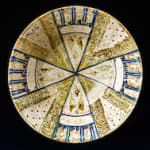Kashan Lustre Pottery Bowl, 1100 CE - 1300 CE
Lustreware
8.4 x 19.3 cm
3 1/4 x 7 5/8 in
3 1/4 x 7 5/8 in
GD.001
Deep bowl on short straight foot ring, decorated with a radial design. This is a classic example of the so-called 'panel style’, the surface being divided into radial triangular panels,...
Deep bowl on short straight foot ring, decorated with a radial design. This is a classic example of the so-called 'panel style’, the surface being divided into radial triangular panels, each panel distinguished by different but recurring abstract patterns distributed in registers and zones, alternatively decorated with white inscriptions reserved against a lustre ground. Dividing lines and inscriptions in this case are highlighted in cobalt-blue. On the exterior, register with inscriptions below the rim and three parallel rows with peacock-eye motifs.
Scholars generally agree that the skills and knowledge for the production of these stunning and intricately decorated lustrewares were imported from Egypt at the end of the Fatimid period and consequently fully mastered by Persian potters throughout the 12th century AD. Numerous artists and artisans that had originally migrated to Fatimid Egypt, were now moving to the new centers of power, bringing along their technical knowledge and skills. The arts continued to flourish, nurtured and protected by culturally enlightened rulers, and Islamic decorative techniques were applied to pottery and ceramics with renewed vigor.
Among the most significant contributions of Muslim craftsmen in the domain of ceramics, lustre was both an expensive technique and a difficult one to master. Metal-based pigments and other substances were diluted and carefully applied to pre-glazed pots. These were then fired in special kilns in which carbon monoxide triggered a chemical reaction which permanently fixed the metallic oxides onto the object’s surface, giving it its characteristic sheen. The art of lustre and polychrome painting during that period was mastered to such an extent that cobalt blue highlights were used to add even more chromatic variety on the surface of vessels. In addition, this bowl clearly confirms the phenomenal heights the art of calligraphy in ceramic decoration reached in Middle East in those years. The beautifully rendered inscriptions on this bowl though are yet to be interpreted.
Kashan, Iran, 14th century.
Scholars generally agree that the skills and knowledge for the production of these stunning and intricately decorated lustrewares were imported from Egypt at the end of the Fatimid period and consequently fully mastered by Persian potters throughout the 12th century AD. Numerous artists and artisans that had originally migrated to Fatimid Egypt, were now moving to the new centers of power, bringing along their technical knowledge and skills. The arts continued to flourish, nurtured and protected by culturally enlightened rulers, and Islamic decorative techniques were applied to pottery and ceramics with renewed vigor.
Among the most significant contributions of Muslim craftsmen in the domain of ceramics, lustre was both an expensive technique and a difficult one to master. Metal-based pigments and other substances were diluted and carefully applied to pre-glazed pots. These were then fired in special kilns in which carbon monoxide triggered a chemical reaction which permanently fixed the metallic oxides onto the object’s surface, giving it its characteristic sheen. The art of lustre and polychrome painting during that period was mastered to such an extent that cobalt blue highlights were used to add even more chromatic variety on the surface of vessels. In addition, this bowl clearly confirms the phenomenal heights the art of calligraphy in ceramic decoration reached in Middle East in those years. The beautifully rendered inscriptions on this bowl though are yet to be interpreted.
Kashan, Iran, 14th century.



